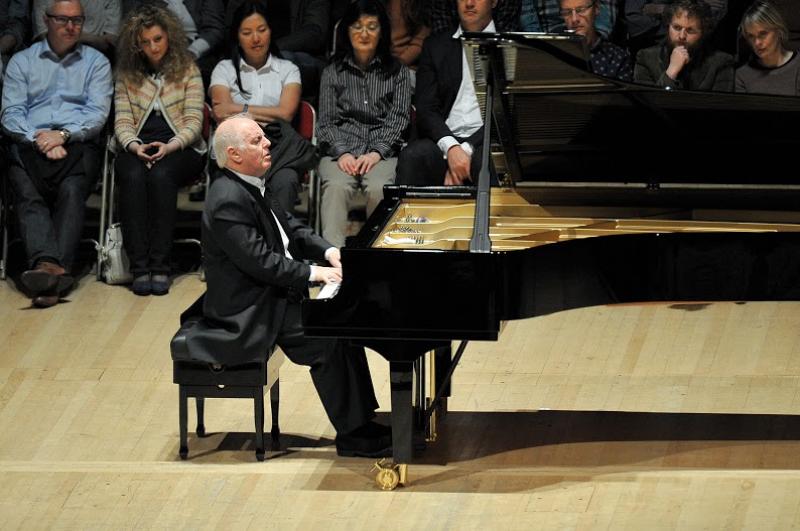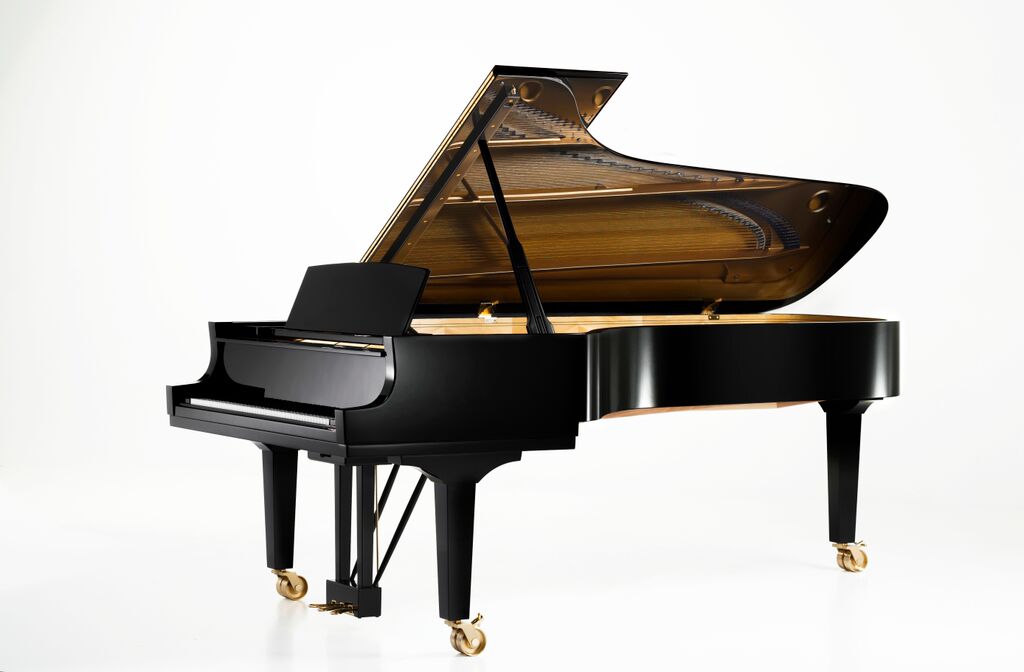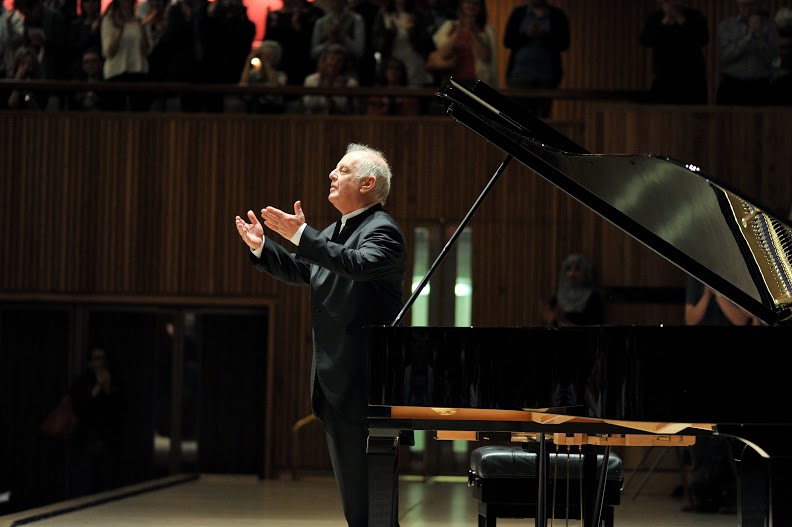Schubert Sonatas 1, Barenboim, RFH | reviews, news & interviews
Schubert Sonatas 1, Barenboim, RFH
Schubert Sonatas 1, Barenboim, RFH
The new instrument sounds sublime, but is the player on this occasion?

It’s not often that you arrive for a piano recital to see members of the audience on the stage, clustering around the instrument and taking photos of it. Those curious about the newly unveiled, straight-strung Barenboim-Maene concert grand (the name above the keyboard is simply BARENBOIM) were periodically ushered away from it; it was closed and reopened several times before it was time for the maestro himself to take control.
The first event in Daniel Barenboim’s four recitals of Schubert sonatas involved several component parts that added up to a distinctly odd evening. Let’s dispatch one right away: the Royal Festival Hall was packed out and due reverence accorded to this living legend of a musician.
Then there’s that piano. The news broke in the UK only the day before that Barenboim had collaborated with the Belgian piano maker Chris Maene to create a special instrument closer in sound and spirit to those of the 19th century than the 20th (pictured below by Maene), inspired by one that had belonged to Franz Liszt.
If you’re going to do that, Schubert is a good target. Anyone who has had to tackle the composer’s music at the keyboard will have discovered that Schubert doesn’t really write for the piano; he seems to have in mind some idealised, non-existent instrument that more resembles a sort of celestial string ensemble. Besides, his liking for long passages involving quiet, rapid, repeated notes, chords or octaves can kill a pianist’s tendons on the heavy action of a modern grand, light years away from the pianos of the composer’s day.
 Barenboim’s new instrument sounds sublime, at least to my ears. Its light, translucent sound sings and sustains all the way from the clear, bright treble range through eloquent alto down to a sepulchral bass; there is no nasty, forced, clangy, bangy sound whatsoever; and its capacity for revealing myriad shades at soft levels is ideal for a composer whose spirit often hovers halfway to the next world.
Barenboim’s new instrument sounds sublime, at least to my ears. Its light, translucent sound sings and sustains all the way from the clear, bright treble range through eloquent alto down to a sepulchral bass; there is no nasty, forced, clangy, bangy sound whatsoever; and its capacity for revealing myriad shades at soft levels is ideal for a composer whose spirit often hovers halfway to the next world.
Various people apparently didn’t like the sound as much as I did. Yet perhaps that is a pointer to the problems with usual modern pianos (and many of their exponents), for our ears have become used to those clangs and bangs and some listeners, sadly, have come to expect it. Great piano playing is about the opposite.
Still, the finest pianists can bring their own personal sound to a honky-tonk down the pub if they wish. The bigger issue is not what Barenboim does with his piano, but what spirit he brings to the Schubert sonatas. That’s where the problems really begin.
This programme involved one sonata in A minor and two in A major; contrast of sonic setting was therefore limited from the start. And the first work is possibly the most problematic in the book. The so-called "little" A minor sonata D537, the first of Schubert’s three in that key, is an early work and very far from a masterpiece. It is full of Schubertian gestures – minor-major switches, lilting Ländler-like moments – yet most are unfocused, underdeveloped and repetitive, often fragmented by abrupt silences. It’s hard to make it convincing; the chief justification for playing it at all is that the slow movement’s theme was later reincarnated as the finale of the great A major Sonata D959. One hoped that if anybody could make it work it would be Barenboim; yet it was hard not to wonder, through this somewhat dutiful and matter-of-fact rendition, whether he believed in the piece himself. The one moment of revelation came in the slow movement when Barenboim emphasised a bass motif that suggested the presence of a funeral march.
The (again) "little" A major Sonata D664 contained the evening’s first moment of actual pianistic magic in the faraway hush of the slow movement’s opening; the twilit passagework in the finale was equally satisfying in its soft, cushioned clarity. But Barenboim still seemed ill at ease with the work’s delicate emotional territory. His pianism can resemble oratory; he phrases melodies the way an actor or a politician might approach a paragraph, picking out and spotlighting the most important note or harmonic incline; and he balances the voices within the textures as if controlling different instruments within an orchestra. But it was only at the few moments when he gave Schubert’s introspection its head and allowed it to enter a dusky private dreamscape that the composer’s essential poetry stood a chance.
 The very real charm and warmth that is the inverse of Schubert’s dark side had scant presence all evening. And without that, the central contrast that gives his music such power simply vanishes. The rawness of the young composer’s emotions, his agonising consciousness of the beauty of life and the likelihood that he must lose it too soon, is often at the core of his appeal. Without tenderness, it doesn’t come off the page.
The very real charm and warmth that is the inverse of Schubert’s dark side had scant presence all evening. And without that, the central contrast that gives his music such power simply vanishes. The rawness of the young composer’s emotions, his agonising consciousness of the beauty of life and the likelihood that he must lose it too soon, is often at the core of his appeal. Without tenderness, it doesn’t come off the page.
Perhaps Barenboim would be more at home in the grander scale "big" A major, D959, the second of the three great sonatas that closed Schubert’s output in the genre shortly before his death aged all of 31. But here, too, the music’s expansive generosity was sacrificed to brusque rigour in the opening movement. The second is one of Schubert’s most visionary and terrifying compositions, descending in its central episode into a kind of inner towering inferno; but though the whole movement had the sombre and relentless tread of a triple-metre march (Brahms Requiem, anyone?), the inferno scarcely caught fire; and towards the end of the movement Barenboim suffered a serious memory lapse. This of course can and does happen to any pianist, but it seemed particularly unfortunate in this context.
Yet Barenboim is often at his finest in music that feels like translated philosophy – perhaps that’s why his Beethoven and Wagner are so special – and when Schubert does allow that approach into the sonatas, the rewards are strong. Towards the end of the A major’s finale, the phrases stop and start, as if Schubert is pausing at an existential crossroads to consider his options; finally he settles with acceptance and courage on the major rather than the minor. As Barenboim showed us the composer’s critical choice, the entire hall breathed and sighed together with them both. It was a moment worth waiting for.
rating
Share this article
The future of Arts Journalism
You can stop theartsdesk.com closing!
We urgently need financing to survive. Our fundraising drive has thus far raised £49,000 but we need to reach £100,000 or we will be forced to close. Please contribute here: https://gofund.me/c3f6033d
And if you can forward this information to anyone who might assist, we’d be grateful.

Subscribe to theartsdesk.com
Thank you for continuing to read our work on theartsdesk.com. For unlimited access to every article in its entirety, including our archive of more than 15,000 pieces, we're asking for £5 per month or £40 per year. We feel it's a very good deal, and hope you do too.
To take a subscription now simply click here.
And if you're looking for that extra gift for a friend or family member, why not treat them to a theartsdesk.com gift subscription?
more Classical music
 Kempf, Brno Philharmonic, Davies, Bridgewater Hall, Manchester review - European tradition meets American jazz
Bouncing Czechs enjoy their Gershwin and Brubeck alongside Janáček and Dvořák
Kempf, Brno Philharmonic, Davies, Bridgewater Hall, Manchester review - European tradition meets American jazz
Bouncing Czechs enjoy their Gershwin and Brubeck alongside Janáček and Dvořák
 Solomon, OAE, Butt, QEH review - daft Biblical whitewashing with great choruses
Even a top soprano and mezzo can’t make this Handel paean wholly convincing
Solomon, OAE, Butt, QEH review - daft Biblical whitewashing with great choruses
Even a top soprano and mezzo can’t make this Handel paean wholly convincing
 Two-Piano Gala, Kings Place review - shining constellations
London Piano Festival curators and illustrious friends entertain and enlighten
Two-Piano Gala, Kings Place review - shining constellations
London Piano Festival curators and illustrious friends entertain and enlighten
 Echo Vocal Ensemble, Latto, Union Chapel review - eclectic choral programme garlanded with dance
Beautiful singing at the heart of an imaginative and stylistically varied concert
Echo Vocal Ensemble, Latto, Union Chapel review - eclectic choral programme garlanded with dance
Beautiful singing at the heart of an imaginative and stylistically varied concert
 Scott, Irish Baroque Orchestra, Whelan, RIAM, Dublin review - towards a Mozart masterpiece
Characteristic joy and enlightenment from this team, but a valveless horn brings problems
Scott, Irish Baroque Orchestra, Whelan, RIAM, Dublin review - towards a Mozart masterpiece
Characteristic joy and enlightenment from this team, but a valveless horn brings problems
 Classical CDs: Voice flutes, flugelhorns and froth
Baroque sonatas, English orchestral music and an emotionally-charged vocal recital
Classical CDs: Voice flutes, flugelhorns and froth
Baroque sonatas, English orchestral music and an emotionally-charged vocal recital
 Kanneh-Mason, Britten Sinfonia, Shave, Milton Court - a grin and a big beaming smile
A pair of striking contemporary pieces alongside two old favourites
Kanneh-Mason, Britten Sinfonia, Shave, Milton Court - a grin and a big beaming smile
A pair of striking contemporary pieces alongside two old favourites
 theartsdesk at the New Ross Piano Festival - Finghin Collins’ musical rainbow
From revelatory Bach played with astounding maturity by a 22 year old to four-hand jazz
theartsdesk at the New Ross Piano Festival - Finghin Collins’ musical rainbow
From revelatory Bach played with astounding maturity by a 22 year old to four-hand jazz
 First Person: Manchester Camerata's Head of Artistic Planning Clara Marshall Cawley on questioning the status quo
Five days of free events with all sorts of audiences around Manchester starts tomorrow
First Person: Manchester Camerata's Head of Artistic Planning Clara Marshall Cawley on questioning the status quo
Five days of free events with all sorts of audiences around Manchester starts tomorrow
 Goldscheider, Brother Tree Sound, Kings Place review - music of hope from a young composer
Unusual combination of horn, strings and electronics makes for some intriguing listening
Goldscheider, Brother Tree Sound, Kings Place review - music of hope from a young composer
Unusual combination of horn, strings and electronics makes for some intriguing listening

Add comment